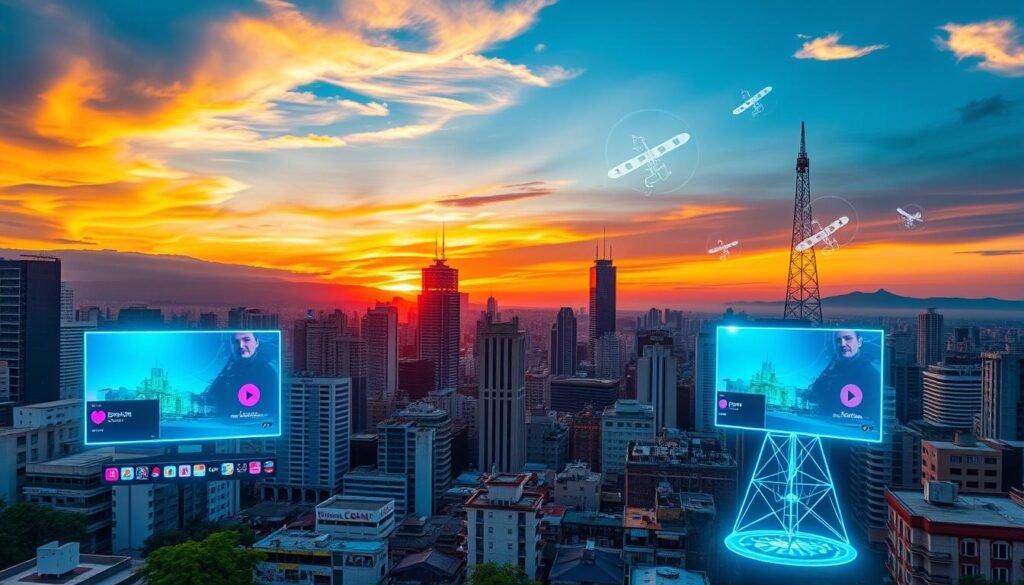The world of Internet Protocol Television (IPTV) is changing fast in Latin America. Streaming services are becoming more popular, and IPTV providers are facing both challenges and chances. This article looks at how IPTV is growing in Latin America, the important factors that influence it, and its potential for success.
Key Takeaways
- IPTV is gaining traction in Latin America as consumers embrace streaming services
- Providers face regulatory hurdles and infrastructure limitations in the region
- Competition from traditional broadcasting and the need for localised content are key challenges
- Technological advances in connectivity and streaming technology are driving IPTV growth
- Expanding broadband access and partnerships with local content producers present opportunities
Overview of IPTV and Its Significance in Latin America
IPTV services and OTT platforms are becoming more popular in Latin America. Internet TV is changing how people watch TV. It’s important to know about this technology and its effect on TV watching habits.
What is IPTV?
IPTV, or Internet Protocol Television, sends TV content over the internet. It lets users watch a lot of shows on their devices connected to the internet. This is different from old TV, where you can’t pause or rewind. Now, you can watch what you want, when you want, on many devices.
The Rise of Streaming Services
Services like Netflix, Amazon Prime Video, and local OTT platforms are changing entertainment in Latin America. They offer a wide range of shows, from international hits to local content. This meets the different tastes of viewers. The ease and flexibility of these IPTV services are making more people choose internet TV.
The mix of OTT platforms with traditional TV is making the media scene more varied and exciting in Latin America.
“The rise of streaming services has revolutionised the way Latin Americans consume entertainment, offering unparalleled choice and flexibility.”
As digital changes keep shaping the media world in Latin America, knowing about IPTV is key. It’s important for both viewers and the industry.
Current Market Landscape for IPTV in Latin America
The IPTV market in Latin America (LATAM) is growing fast. IPTV is becoming more popular. This is because people want more video-on-demand and live streaming.
Key Players in the IPTV Market
A few big names lead the IPTV market in Latin America. They offer different things to attract customers. Some of these players are:
- América Móvil’s Claro TV, a leading provider in countries like Mexico, Colombia, and Brazil
- DirecTV Latin America, a subsidiary of AT&T, offering IPTV services across multiple LATAM countries
- Telefónica’s Movistar TV, a prominent player in markets such as Argentina, Peru, and Chile
- Local providers like Cable Onda in Panama and VTR in Chile, catering to specific national markets
Regional Differences in IPTV Adoption
The use of IPTV in Latin America changes from country to country. Some places, like Mexico and Brazil, use IPTV a lot. Others, like Venezuela and Ecuador, are just starting.
This difference comes from things like how well the internet works, what people like watching, and how affordable video-on-demand is.
“The LATAM market is a patchwork of opportunities and challenges, with IPTV providers navigating a diverse landscape to meet the unique needs of each country.” – Industry Analyst
As IPTV grows in Latin America, providers are changing how they work. They want to give users a better experience that fits what they like.
Major Challenges Facing IPTV Providers
IPTV services are growing in Latin America, but providers face many challenges. They deal with regulatory hurdles, infrastructure limits, and competition from traditional TV. To succeed, they must navigate a complex market.
Regulatory Hurdles
The regulatory environment in Latin America is tough for IPTV providers. Laws and policies, made for traditional TV, block their growth. Providers struggle to comply with changing rules, which slows their innovation and expansion.
Infrastructure Limitations
Broadband quality and availability are big issues for IPTV providers. Not everyone has fast internet, which IPTV needs. Providers must upgrade infrastructure and work with telecoms to reach more people.
Competition with Traditional Broadcasting
Traditional TV in Latin America is a big competitor for IPTV. TV networks have money, loyal viewers, and strong brands. IPTV must offer great content, easy use, and new features to attract viewers.
For IPTV providers to thrive in Latin America, they must tackle these challenges. They need to adapt, invest in infrastructure, and stand out from traditional TV. This will help them grow and succeed in the market.
Technological Advances Driving IPTV Growth
The growth of IPTV in Latin America is fast thanks to new tech. Better internet connectivity and new streaming tech are changing how we watch content.
Improved Internet Connectivity
Latin America has seen more homes get fast internet. This has helped IPTV grow, making streaming smooth for everyone.
Innovations in Streaming Technology
New streaming tech is making IPTV more popular. Better video quality and faster streaming are meeting the needs of tech lovers.
“The combination of better internet connectivity and more advanced streaming capabilities has been a game-changer for IPTV in Latin America, unlocking new opportunities for content creators and service providers alike.”
With these tech improvements, IPTV in Latin America is set for more growth and innovation.
Consumer Behaviour and Preferences
The IPTV market in Latin America is growing fast. It’s key for IPTV providers to know what viewers like and watch. The region’s varied people show different ways of using IPTV services.
Viewing Habits across Different Demographics
Younger people in Latin America love video-on-demand for its ease and flexibility. On the other hand, older viewers prefer traditional TV shows. This shows IPTV needs to offer something for everyone.
The content localisation trend is big in the LATAM market. Viewers want shows that show their culture and local interests. IPTV providers are now working with local creators to meet this need.
“The increasing preference for local content is a testament to the diverse cultural landscape of Latin America, and IPTV providers must adapt their strategies to capitalise on this trend.”
As IPTV grows in the region, knowing what viewers want is key. IPTV providers must keep up to offer a viewing experience that feels personal.
Opportunities for Growth in the IPTV Sector
The IPTV market in Latin America is growing fast. There are big chances for growth in two main areas. These are making broadband access wider and teaming up with local content makers.
Expanding Broadband Penetration
More people are using IPTV because broadband is getting better. Governments and internet companies are working hard to improve the internet. This makes it easier for more people to get online.
As more people get fast internet, IPTV can reach more viewers. This is good news for IPTV services.
Partnerships with Local Content Producers
IPTV services are working hard to offer content that locals love. They team up with local creators to make shows that fit what people in Latin America want to watch. This makes IPTV more appealing and helps the local media industry grow.
| Key Opportunities for IPTV in Latin America | Potential Impact |
|---|---|
| Expanding Broadband Access | Increased reach and accessibility of IPTV services |
| Partnerships with Local Content Producers | Improved content localisation and enhanced viewer engagement |

IPTV providers in Latin America can grow by focusing on these areas. They can improve by expanding internet access and working with local creators. This will help them succeed in a competitive market.
The Role of Mobile Devices in IPTV Consumption
The world is moving towards being more mobile, and this change is clear in how we watch streaming video and IPTV. In Latin America, smartphones and tablets have changed how people use IPTV. They make it easy and accessible.
Trends in Mobile Usage
More people are using mobile devices, which has led to a rise in mobile IPTV. By 2022, there were over 447 million mobile subscriptions in Latin America. Over 70% of people in some areas have smartphones. This has made it easier for everyone to watch streaming video and IPTV on the go.
Accessibility and Convenience
- Mobile devices are easy to carry and use anywhere. This has changed how we watch our favourite streaming video and IPTV services. It has made watching content easier than ever.
- Being able to use OTT platforms and mobile apps easily has made things better. It lets viewers move between devices without trouble. They can keep watching what they like, no matter where they are.
- The introduction of 5G technology has been key. It gives the fast speeds and low delays needed for good streaming video on phones. Even in places with poor internet, 5G makes watching videos smooth.
Mobile devices play a big part in how people watch IPTV in Latin America. This shows how the region is changing digitally and how viewers’ tastes are shifting. As more people use mobile devices, IPTV providers need to keep up. They must make sure their services work well on all devices for a great viewing experience.
Regulatory Environment Impacting IPTV
The IPTV industry in Latin America is growing fast. Content providers and distributors face a complex set of rules. Government policies and regulations shape the IPTV market. Copyright and content licensing issues add to the challenges.
Government Policies and Regulations
In Latin America, different governments have their own rules for IPTV. Some countries have strict rules, while others are more relaxed. These rules can affect how well IPTV providers can offer their services.
Issues of Copyright and Content Licensing
IPTV’s digital nature raises big questions about copyright and content licensing. Providers must make sure they have the right to show local and international content. Content localisation is key for IPTV services in the LATAM market. They aim to meet the varied tastes and cultural needs of their viewers.
“Navigating the regulatory environment is critical for IPTV providers looking to succeed in Latin America. Striking the right balance between compliance and innovation will be a key determinant of their long-term viability.”
The IPTV industry in Latin America is changing fast. Providers need to keep up with new rules and content licensing issues. By doing so, they can grow and succeed in this fast-paced market.
Case Studies: Successful IPTV Implementations
In the fast-changing world of IPTV services, Latin America is leading the way. We can learn a lot from the top IPTV providers in the region. They show us how to succeed in this market.
Examples of Leading IPTV Services
Claro TV is a top example. It’s offered by América Móvil, a big name in Latin American telecom. Claro TV is big in Mexico, Colombia, and Brazil. It uses its wide reach and strong content partnerships to offer a great IPTV service.
DirecTV Latin America is another success story. It’s part of AT&T and has made a big splash in IPTV. With lots of channels, on-demand content, and easy-to-use features, DirecTV Latin America has won over many viewers.
Lessons Learned from Market Leaders
- Strategic partnerships with content providers and local broadcasters are crucial for success.
- Investing in strong infrastructure and using the latest streaming video tech is key for a smooth viewing experience.
- Customizing content and interfaces for Latin American tastes has helped boost IPTV services adoption.
These examples show how important innovation, flexibility, and understanding the local market are. They are the keys to success in Latin America’s booming IPTV scene.

“The key to success in the IPTV market is to consistently deliver a compelling and tailored experience that resonates with the unique needs and preferences of Latin American consumers.”
The Future of IPTV in Latin America
The IPTV market in Latin America is set for exciting times. With the growth of internet TV and cord-cutting, the future looks bright. Experts believe there will be more expansion and innovation.
Predictions for Market Evolution
Analysts say the IPTV market will see more subscribers. This is thanks to better internet and a desire for more content. Streaming tech and mobile integration will improve user experiences and attract more people.
Long-term Implications for Users and Providers
Users in Latin America will soon have more content choices and better video quality. They’ll also get more tailored viewing experiences. For IPTV providers, staying ahead means investing in new tech and content.
Providers must keep up with viewer tastes and trends. This includes the growth of IPTV and cord-cutting. They need to adapt to stay competitive and succeed in the future.

